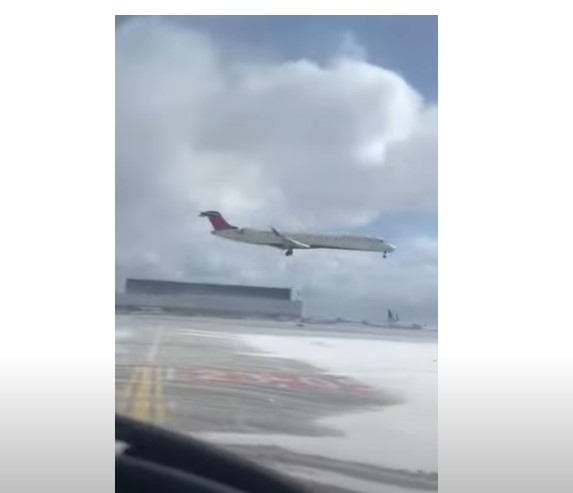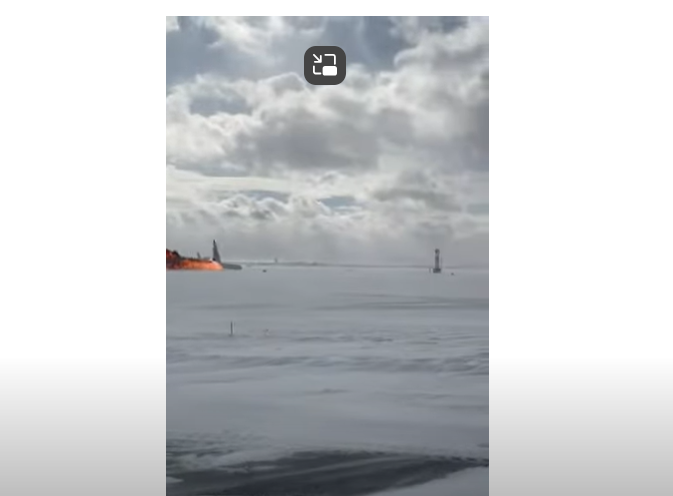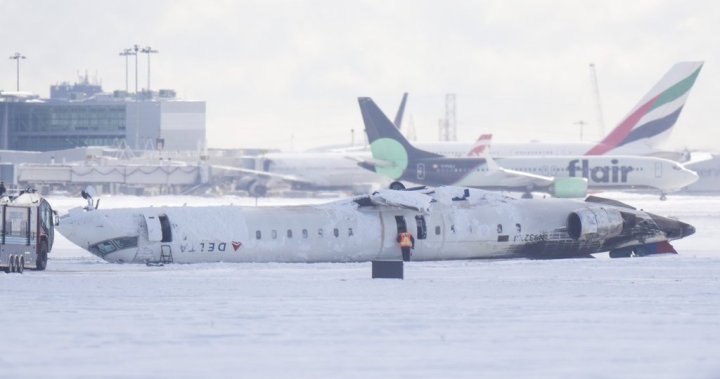The Delta Air Lines regional jet that crashed at Toronto’s Pearson International Airport on Monday appears to have suffered a right main landing gear failure during a high vertical speed approach and hard landing, a veteran pilot says.
The pilot, who has flown the CRJ aircraft across North America for years, shared their assessment with Global News after watching videos of the aircraft’s final approach prior to the crash multiple times.
Global News is not identifying them because they are not authorized to publicly comment on aviation incidents.
Of the 76 passengers and four crew members aboard, 21 people, including a child, were injured after the Bombardier CRJ-900 flipped on the tarmac after it crashed.
Videos of the final moments before the fiery crash began circulating on social media on Tuesday.
One 44 second video uploaded to YouTube shows the final approach of the Bombardier CRJ-900 that was shot from a spot on the right side of the aircraft somewhere at Pearson International Airport.
The veteran pilot said this video appears to show the flight crew executing a very hard landing for reasons that aren’t clear.
“He’s flying very fast. The question is why,” the pilot said.
No ‘flare’ on landing
The pilot said that the video at 12 seconds does not appear to show the flight crew making an aviation maneuver known as “a flare” moments before landing.

A Delta Air Lines CRJ-900 jet seen here on its final approach at Pearson International Airport in Toronto seconds before it crashed on Feb.17, 2025. The video depicted no flare, or raising of the jet’s nose upward by the pilot, to slow speed before it touches down.
YouTube
Pilots perform a flare by pitching the jet’s nose gently upward. This slows the aircraft to reduce the jet’s vertical speed when it touches down and rolls down the runway to the terminal.
The jet will always flare a small amount when the leading edge slats on the wings are activated for landing, but the pilot said he didn’t see a fully obvious pilot-initiated visual flare that slowed the jet.

Get daily National news
Get the day’s top news, political, economic, and current affairs headlines, delivered to your inbox once a day.
“You don’t see the jet’s nose floating upwards for one or two seconds before he touches down,” the pilot said. “The question is: why did the vertical speed not drop? Where was the flare?”
The pilots were grappling with strong crosswinds at the time, the veteran pilot suggested.
It is possible the Delta pilot’s primary objective was to stay in the centre of the runway and flaring would have become a secondary issue as they were buffeted by gusts.
Landing gear collapse
Because the jet was travelling fast and appears not to have been slowed by a flare before touchdown, the video shows at 17-18 seconds what happened next: the right main landing gear appears to have collapsed under the burden of the hard, fast landing.
Delta CRJ-900 landing gear hits the ground at 17 seconds in the video and the main right landing gear appears to fail.
YouTube
The video shows the right wing then struck the ground at high speed as the jet hurtled down the runway.
At 20-21 seconds, it appears the right wing was then sheared off, the pilot said.
Passengers who survived the crash have also since spoken of a very hard landing before the aircraft lost control and flipped.
However, the aircraft’s left wing remained initially intact.

One of the jet’s wings is still visible at 19 seconds into the video.
You Tube
“The right wing is broken, but the left wing is intact and it’s going fast enough to produce lift and still wants to fly. That’s when the plane flips upside down due to a lift imbalance.”
The right wing on the Delta CRJ-900 jet appears to have been sheared off and is gone from a video frame at 21 seconds and the aircraft has burst into flames.
YouTube
What may have saved the passengers’ lives?
The pilot says the wing being sheared off the CRJ-900 during the crash landing and the jet flipping upside down may actually have saved the 76 passengers’ lives.
Here’s why: Fuel from a tank inside the sheared wing would have rapidly spilled out onto the tarmac instead of catching fire as part of a larger blaze that would have quickly overcome the passengers and crew had the jet remained right-side up.
A CRJ jet of that size can carry up to approximately 18,000 pounds of aviation jet fuel (10,000 litres) — around 4,000 pounds in the belly and 7,000 pounds in tanks in each wing. By the time the aircraft lands, it may still have between 4,000 to 6,000 pounds remaining.
A Delta Air Lines plane lies upside down at Toronto Pearson Airport on Tues., Feb. 18, 2025. Flight 4819 — a Bombardier CRJ-900 jet operated by the Delta subsidiary Endeavor Air, crashed while landing in Toronto having flown from Minneapolis on Monday. The right wing can be seen above ripped off the jet.
Chris Young / The Canadian Press
The veteran pilot suggested regional airline aviators are among the hardest-working flyers in the business and may not have been in any way at fault for what happened.
Two black boxes are present in a Bombardier CRJ-900 and the contents should answer key questions.
One of them captures flight data. The other captures the communications between pilots and their spoken communications with the air traffic controller in the airport tower.
The pilot added that the black boxes should be in good shape because the fuselage is intact and aviation accident investigators will have recovered them quickly and likely have already begun to analyze their contents.
The Transportation Safety Board of Canada is investigating the crash, with assistance from its American counterpart agency, the National Transportation Safety Board.




